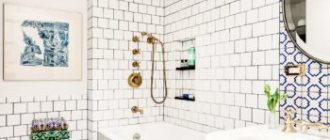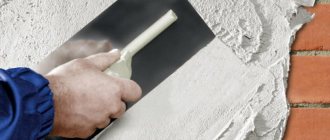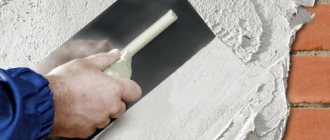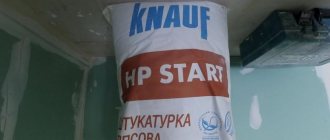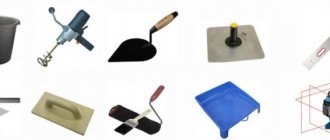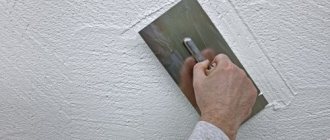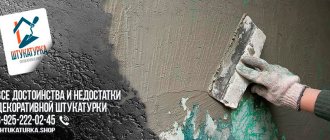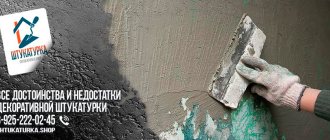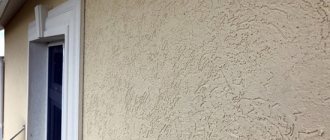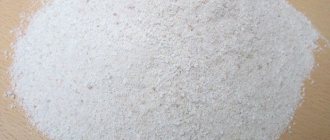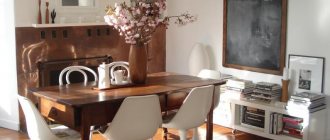Light gypsum plaster TEPLON WHITE from Eunice | UNIS heat-saving 30 kg, consumption calculation:
For a surface area of m2 and a layer thickness of mm, kg is required. Cost per kg – rub.
When carrying out construction or renovation work, it is important to purchase materials in the correct quantities. If too many are purchased, it will lead to unnecessary losses, and if too few are purchased, resources may run out unexpectedly and repairs will be delayed indefinitely. It can be quite difficult to make the necessary calculations yourself, so we recommend using our online consumption rate calculator. It will show how many goods you will need and how much it will cost to purchase it on Skladom.ru. This way, you can avoid unnecessary expenses and get rid of the need to waste time on calculations.
How our calculator is useful
Regardless of whether you are building a large house or renovating an apartment, our building materials calculator will help you understand in what volume you need to purchase certain products and how much you will have to spend on them. You will also see the characteristics and description of the selected product, the price of one package and availability information.
Working with the calculator
To carry out calculations you need to do the following:
- 1. Select the type of material.
- 2. Select a specific product.
- 3. Indicate the surface area - at least 1 m2.
- 4. Specify the layer thickness in millimeters.
- 5. Click the “Calculate” button.
Afterwards you will immediately see how many kilograms of goods you will need, how many packages they are and what their cost is. Additional information will be provided below.
Placing an order
Another advantage of our calculator is that you can immediately purchase the materials you calculated. To do this, you need to click the “Buy” button and then place your order through the “Cart”. You can also contact our managers by phone for help.
How to apply Teplon
At the first stage, it is necessary to carry out preparatory work. To do this, you need to remove old plaster and wallpaper from the surface to be treated. Also, the walls need to be washed and dried. All “growths” must be cut off. Despite the fact that the composition has good adhesion, it is recommended to apply small notches to the surface. After this, the walls must be coated with a primer (2-3 layers) and Teplon solution diluted.
Preparing the mixture
The solution must be diluted according to the proportions indicated on the package. The standard ratio is 1 kg of plaster per 0.45-0.55 liters of water. However, if you use white plaster, then the volume of water must be increased to 1.8 -2.2 liters.
Healthy! If there is too much water, the solution will simply spread over the surface. If you are greedy with water, the diluted composition will begin to crack.
The mixture must be thoroughly mixed with water; it is best if you have an electric mixer or drill with an appropriate attachment on hand. After mixing, the solution must be left for 5-6 minutes, after which the plaster is mixed again.
It is recommended to prepare the mixture in small portions. Some believe that it is better to do a large volume of material at once, so as not to suffer later with constant stirring and waiting. In this case, this approach will not work. The “life” of the plaster is only 50 minutes (it is recommended to do it within half an hour), after this time the mixture will become unusable. If you use already “expired” material, the coating will be very fragile. After some time, such plaster will simply crumble.
Applying plaster
To apply the prepared solution to the wall, just use a trowel or spatula (preferably of different sizes). It is best to purchase tools that are made of stainless steel.
Healthy! The mixture can only be used at temperatures from +5 to +30 degrees.
After the composition has been applied to the surface, it is necessary to treat it with a rule to remove all irregularities. After a few hours the plaster will harden.
If you used white plaster, then 1.5-2 hours after applying it, you need to go over the surface with a sponge grater.
After this, you need to wait about a week until the composition completely hardens. Complete drying is calculated based on the fact that a 10 mm layer will completely harden in 5-7 days at a temperature of +22 degrees and normal humidity.
Description
White gypsum plaster “UNIS Teplon” (30 kg) is suitable for interior decoration of walls and ceilings. After drying, it forms a smooth, glossy surface and does not require the application of putty. The perlite included in the mixture makes it light and increases the heat-shielding characteristics.
Material Features:
- Suitable for sealing seams and cracks up to 7 cm in depth.
- The layer when applied without a mesh on the wall is up to 5 cm.
- The layer when finishing the ceiling is up to 3 centimeters.
- The solution must be used within 50 minutes.
- Consumption when applying a layer of 1 cm is up to 8-9 kilograms per square meter.
Advantages:
- Easy.
- Sets within 3 hours.
- Breathing.
- Does not require application of an additional finishing layer.
- Resistant to cracks.
How long does it take for Teplon to dry?
Teplon belongs to the category of quick-drying materials. The time of complete drying is influenced by the characteristics of the mixture and the thickness of application. Performance characteristics are achieved 5-7 days after application.
While the layer is drying, the use of heat guns, heating devices or direct sunlight is not allowed. This leads to uneven drying and the appearance of cracks.
Drying plaster with various heat devices will lead to cracks.
Buy “UNIS Teplon white 30kg (gypsum plaster)”
easy - just call
Reviews Gregor
04.11.2014 01:08:37
Suitable for wallpaper but not suitable for painting. because it still didn’t give such evenness. We were told that it also depends a lot on the master, maybe we’ll try again even to test ourselves. The store is quite good, the prices are lower and you can find a lot of what we need.
Alternative-S
01.07.2013 01:07:51
Good material. I liked it because it’s economical, but I also don’t like fiddling with the mesh, and I don’t need a mesh under it, so I bought it for this purpose. Essentially, it’s universal, good for wallpaper, good for painting too, I tried it. good manufacturer, have already worked with his products. I'll take more.
Ivanka
16.06.2013 23:19:41
I don’t know why they praise it so much – I didn’t really like it. Too painstaking in application, a lot of nuances that you need to know, otherwise the layer will turn out uneven, not smooth... Moisten, rub, gloss... This is all good, but if you do it yourself, as we did, then it’s easier to take something less whimsical. Next time we’ll take a Volma or something similar, or we’ll hire people for such work.
Ilya Bolotov
14.04.2013 19:27:23
This plaster is not suitable for rooms with high humidity. I think that this is its only drawback, but we use it regularly. We ordered Eunice Teplon here, paid by card through a payment terminal, ordered with delivery and unloading. The guys delivered and unloaded everything on time, without any reminders.
Alexandra
28.02.2013 12:28:29
We bought a new apartment without finishing, bare walls. Everything was plastered and leveled with this plaster. Very good quality, smooth white, applies in an even layer. After leveling, the master treated the ceiling in a special way, so it turned out glossy, it looks great and nothing else is needed.
Scope of application
The Eunice Teplon mixture has excellent performance characteristics. Thanks to this, it has become widespread in various areas of finishing. It is actively used for leveling surfaces in residential and industrial premises with normal humidity levels. Thanks to its environmentally friendly composition, it is safe for children's rooms and bedrooms.
Teplon is an environmentally friendly material, so it can be used in decorating a children's room
Teplon in combination with a proprietary primer has a high degree of adhesion. Thanks to this, bases made of brick, concrete, wood, foam blocks, and gypsum are leveled with gypsum compounds.
The scope of use of plaster is clearly shown in the table.
| Application area | Compatibility |
| Interior work | Yes |
| Exterior works | No |
| Brick | Yes |
| Concrete/reinforced concrete | Yes |
| Foam block | Yes |
| Old plaster | Yes |
| Rooms with normal humidity | Yes |
| Wet areas | Only marked “moisture resistant” |
| In conditions without heating | Only marked “moisture resistant” |
| For decorative purposes | No |
| As a texture wallpaper | Yes |
| In specialized institutions | Yes |
Teplon is not used as a finishing material in bathrooms, swimming pools and other rooms with high humidity. It is allowed to apply material marked “moisture resistant” under tiles and other types of finishes.
Scope of application of Teplon plaster mixtures
Scope of application of Teplon plaster
Unis Teplon plaster is much lighter compared to other gypsum plasters.
In addition, Teplon gains strength faster compared to cement plasters. Its only drawback is its low moisture resistance: it can absorb moisture up to 400% of its own weight . That is why this kind of mixture is intended only for interior plastering work.
Teplon's enhanced water absorption has both positive and negative effects for builders
One of the advantages of the mixture is the high strength of the finished coating, due to its gypsum viscosity and low weight. Therefore, it is successfully used for:
- plastering the surface (wall and ceiling) without the use of reinforced mesh;
- preparation for painting;
- preparation for facing with expanded clay tiles;
- removal of small depressions up to 7 cm deep.
Like all gypsum plasters, Teplon creates a smooth, even and glossy surface even without additional putty.
Can be used for the following types of surfaces:
- wooden;
- brick;
- gypsum;
- gas and foam concrete.
All surfaces should be pre-treated with a primer before plastering.
At the last stage it is not necessary to use a plaster mesh. The consistency of the solution is homogeneous, light and characterized by rapid setting .
All this adds up to significantly speed up construction work and increase productivity.
Methods for applying the finished solution
The simplest method is manual. After preparing the Unis composition, you need to use a spatula or trowel for further work. In this case, it is best to use steel tools, since these are the ones recommended by experts and the manufacturer.
After applying the solution, you need to wait about an hour, after which you should treat the surface using the rule, remove roughness, if any, and fill the recesses. After another 30-60 minutes, the surface should be moistened and treated with a special sponge grater.
The composition should harden within 3 hours after application. At this stage, it is completely ready for further work, namely for painting or, for example, for wallpapering.
Of course, this procedure is quite simple, especially for a person who is not doing it for the first time. Despite this, it can take a lot of time even for a team of craftsmen if a wide scope of work is planned. In this case, modern technology comes to the rescue, reducing work time significantly and increasing labor productivity. The Eunice mixture is most quickly applied using a mechanical method, which involves the use of a special automatic mobile station.
How does the process of mechanized application of the solution on surfaces take place? The apparatus for performing this work is quite simple. It consists of the following components: a compressor, a special medium-power screw pump, a drive, a chassis, and auxiliary parts. This station also has a compartment for mixing the solution. It is into this that the mixture is poured and water is poured.
The machine takes on the function of mixing the ingredients, so the consistency of the final composition is exactly what it should be. This is due to the fact that the process is not influenced by the human factor, and several operating algorithms are already programmed inside the device.
Once the plaster is ready for use, the machine feeds it into a hose under pressure. Next, it enters the gun, with which it is evenly sprayed onto the surface to be treated. Due to this, maximum operating speed and high quality surface treatment are achieved.
TEPLON is a real godsend for home first aid kits!
Effective.
TEPLON warms up with a constant temperature that does not change over time for a clearly measured time. It creates local heating in the very “epicenter” of the disease, in the diseased organ. Safe. The device allows you to select the optimal temperature regime that is comfortable for a person. Unlike electric heating pads, TEPLON is approved for use in medical practice.
Has a complex effect. The use of TEPLON in combination with drug therapy increases the effectiveness of treatment without increasing the total dose of the drug, reducing the risk of adverse reactions.
Convenient to use. TEPLON does not require special conditions for use. The device does not stain clothes and is easily disinfected. With TEPLON you can simultaneously warm up several zones: for example, the chest and back, or the nose and feet, etc.
Benefits of plaster
The material does not contain chemicals harmful to the body and conducts heat well.
The consumption of the mixture per 1 square meter is minimal , which makes it possible to spend it economically. The dimensions of the room are practically preserved; plastering takes only 5-10 cm of the room along its perimeter, depending on unevenness and defects.
is very plastic in use and easily takes the required shape when filling cracks and depressions. Good elasticity allows the mixture to remain stable for a long time and not crack; the material does not decrease in volume - it does not dry out or shrink afterwards.
Thanks to its resistance to mechanical stress, Eunice Teplon White plaster applied to the surface of a wall or ceiling will not be damaged if you hammer a nail into it and hang a heavy decorative element on it. The plaster layer will not deform or collapse.
Return to content
Composition of Teplon
The main component of the mixture is gypsum, which acts as a binder. In addition, Teplon contains a natural material - perlite, which is an expanded crumb of natural mica. Thanks to this component, the plaster retains heat. In addition, perlite makes the mixture very light and speeds up the hardening process. On the other hand, it is precisely because of this component that plaster cannot be used for exterior work.
In addition to fine filler, synthetic additives are added to the mixture.
In terms of their composition, Yunis products are practically no different from similar Knauf Rotband compositions. Therefore, it is impossible to say which is better: Rotband or Teplon. However, there are a few differences:
- Yunis is a Russian manufacturer, and Knauf is a German company.
- The cost of domestic putty will be approximately 60 rubles lower.
In all other respects these are two identical compositions. Therefore, you choose - Teplon or Rotband. If we talk about the properties of these compositions, they are also no different.
Properties and cost of Teplon
Before moving on to finishing work, it will be useful to familiarize yourself with the technical characteristics and properties of gypsum plaster:
- Strength is 2.5 MPa per 1 cm2. In this case, the plaster can withstand pressure of more than 25 kg. By the way, the strength characteristics of the same drywall are not much more (3-5 MPa).
- The maximum layer thickness for ceilings is 3 cm, and for walls 5 cm. However, it is better to apply the plaster in a layer of about 0.5-0.7 cm. If you want to increase the thickness of the finishing material, you can use reinforcing mesh.
- Frost resistance – F35.
- Colors. The plaster is available in two colors - white and gray. It is worth considering that the white mixture may differ slightly from the gray composition in its properties, so before using it, be sure to read the instructions on the package.
- Thermal conductivity of Teplon is 0.23 W/m oC.
- Adhesion. The solution adheres well to the surface. The adhesion level is 1.0 kgf/cm2. Thanks to this, when applying a layer of up to 0.7 cm, there is no need to use a reinforcing mesh.
- Moisture absorption. Gypsum plaster, which contains perlite, absorbs moisture very well.
- The consumption per 10 kg will be about 4.5-5.5 kg of Teplon. The mixtures are sold in packages of 15 and 30 kg. If we talk about consumption per 1 m2, then no more than 8.5-10 kg of mixture will be needed per “square”. The cost will be about 130 rubles.
If we talk about the cost of mixtures, then:
- Eunice Teplon white plaster will cost 150 rubles for a 15 kg package and about 340 rubles for a 30 kg bag.
- The gray composition costs a little less, from 278 to 310 per 30 kg.
Before purchasing, it is worth deciding on the scope of work and clarifying whether the selected composition is suitable for a particular room.
Types of plaster Teplon
There are 7 types of Teplon brand plasters in the Yunis line:
- white (thermal insulating, lightweight);
- white Gold (lightweight, reinforced thermal insulation);
- reinforced (with thermal insulation effect);
- moisture-resistant next aquagypsum;
- universal;
- MH-180;
- ecolayer.
The enterprises of the manufacturer Unis, where they produce gypsum mixture, are located next to gypsum deposits. Depending on the mineral composition of natural raw materials, the output products are white and gray. Hence the two main colors: white and gray (with intermediate shades).
Eunice teplon white
Eunice teplon white Gold
In addition to them, the line contains a gray-beige mixture, which contains polymer additives that increase moisture resistance. The products in the line have slightly different properties.
Table: thermal plaster characteristics
| Characteristics | Universal | White (lightweight with perlite) * | White Gold (reinforced) * | Reinforced * | Ecolayer | Next Aquagypsum | MN 180* |
| Consumption per layer 10 mm for an area of 1 m2 (kg) | 12.0 – 13.0 | 8.0 – 9.0 | 9.0-10.0 | 10-11 | 11-12 | 8-9 | |
| Leveling thickness layer (cm) for walls | 0.5 — 4.0 | 0.5 – 5.0 | |||||
| Same for ceilings | up to 3.0 | up to 1.5 | up to 3.0 | ||||
| The same, in small areas | up to 6.0 | up to 7.0 | |||||
| Application | manual, machine | cars | |||||
| Volume (l) of added water | 5.5 – 7.0/per 25 kg | 13.5 – 18 / per 30 kg | 11.2 – 13.8/per 25 kg | 0.4-0.5/per 1kg | 0.3 – 0.4/per kg | 9.5-11.25/per 25 kg | 12-15/per 30 kg |
| Strength (compressed in MPa) | 5.0 | 2.5 | 3.5 | 3.0 | 3.0 | 2.5 | |
| Dough viability(min) | Beginning grab | 60 | from 60 | 60 | 90 | 120 | |
| End of grasping. before | 240 | 180 | 240 | 240 | |||
| Adhesion (kg/cm2//MPa) | 0.4 | 0.3 | 0.5 | 0.3 | 0.4 | 0.3 | |
| Drying time for 10 mm layer (days) | 5 – 7 | ||||||
| Plaster color | From white to gray | white | |||||
| Packaging (kg) | 25 | 30, 25, 15, 5 | 30 | 25 | 30 | ||
| Thermal conductivity | — | 0.23 W/m°C | — | — | — |
Reviews
Eunice Teplon is a high-quality finishing mixture. It allows you to create a strong, even coating for any type of finishing. The solution is environmentally friendly, completely safe and has low consumption. Low cost combined with excellent performance characteristics makes it the optimal material for interior decoration.
Have you worked with the Eunice Teplon mixture? Share your impressions of the composition in the comments.
Advantages and disadvantages
The most durable and guaranteed way to make the ceiling and walls smooth is to plaster them. Let's try to weigh all the pros and cons of this method.
| Advantages | Flaws |
| Possibility to do without reinforcement | Presence of dust and dirt during application |
| Environmental friendliness, vapor permeability, heat protection | The need to make grooves to mask communications |
| Economical | A lot of time is spent on performing work and drying the solution |
| No shrinkage or cracking of the coating | |
| Plasticity of solution | |
| No need to apply putty after drying | |
| Almost does not reduce the dimensions of the room | |
| Normal tolerance to mechanical stress |
Due to its positive qualities, Teplon gypsum plaster guarantees a good result of repair work.
Return to content
Places of application
Eunice Teplon White plaster is used to level ceiling surfaces and walls in rooms with moderate humidity.
| Area of use | Compatibility |
| For interior work | + |
| For outdoor use | — |
| Under a brick base | + |
| For concrete/reinforced concrete | + |
| Under foam concrete | + |
| Under old plaster | + |
| In dry rooms | + |
| In wet | Moisture resistant only |
| In unheated | Moisture resistant only |
| As decoration and plaster | — |
| Like texture wallpaper | + |
| For special institutions | + |
Suitable for almost any load-bearing surfaces, except bathrooms . The exception is a wall that is insulated from moisture. This can be achieved by laying tiles or ceramics over plaster. The seams should be carefully rubbed down. When in contact with any type of coating - brick, concrete, wood, it retains its useful qualities - plasticity, good adhesion and vapor permeability. The only condition is that the primer for each surface must be selected accordingly, and the whitewash must be removed before starting work with plaster, and only then can priming begin.
The main composition of Teplon White is gypsum. Additionally - special fillers - expanded perlite or glass hydroxide of volcanic origin. This allows for increased thermal insulation ability.
Similar products
327.00 10.90.90 Gypsum plaster Prospectors 30 kg 367.00 12.23.23 Gypsum plaster Knauf Iceberg 30 kg 362.00 12.07.07 Gypsum plaster Volma Layer 30 kg 380.00 12.67.6 7 Gypsum plaster Weber Vetonit Easy gyps 30 kg 415 .00 13.83 .83 Gypsum plaster Knauf Rotband 30 kg 247.00 8.23 .23 Gypsum plaster Axton 30 kg 263.00 10.52 .52 Gypsum plaster Unis Next Aqua gypsum 25 kg 323.00 12.92 .92 Pieces gypsum plastering Volma Layer ultra 25 kg 328 .00 10.93 .93 Gypsum plaster Bergauf Easy Band 30 kg 180.00 12.00 .00 Gypsum plaster Prospectors 15 kg 303.00 10.10 .10 Gypsum plaster Osnovit Pro 30 kg 435.00 14.50 .50 Plaster gi canine Glims Satin 30 kg 218.00 7.27.27 Gypsum plaster Best Price 30 kg 344.00 11.47.47 Mechanized gypsum plaster Volma 30 kg Show all Similar products Based on 129 ratings Write a review 80% of customers recommend this product Price Quality Rated reviews Popular reviews S Sergey March 11, 2021 .disappointed in the warm. There were some bags left from the batch of 08/24/2018, they fit perfectly, I decided to buy a couple more bags to decorate the walls, and it was as if they had been lowered underground from heaven, I couldn’t plaster 1 m2, I came across about 60 grams of “cobblestones” measuring 10-12 mm, about what Are we talking about 5 mm leveling? Advantages: The 2021 batch is much better than the 2019 batch Disadvantages: I bought a defective batch on 03/11/2019, the stone fraction is 12mm, what 5mm are we talking about Andrey Polyansky Unis technical specialist Good afternoon, Sergey. Please write your contact details by email. This fact requires a detailed check. E Evgeniy May 02, 2021 This is not plaster in the usual sense. 30 kg of Teplon is one and a half times smaller in volume than any other plasters of the same weight. The required volume of water is also one and a half times less than analogues. Inside there is an incomprehensible substance with the consistency of cement-sand mortar, beige in color. It sets 15-17 minutes after mixing, regardless of a clean container, clean cold water and a short shelf life. It cannot be trimmed: it either breaks out in pieces or hardens. It was not possible to choose the optimal time for pruning. It SMELLS TERRIBLY of plasticizer for concrete grade “C3”. Advantages: none Disadvantages: No additives to retard setting, a lot of coarse sand, one big drawback. Andrey Polyansky Representative of the supplier “UNIS” Good afternoon, Evgeniy! We are sorry that you were not satisfied with the quality of the plaster. The color of gypsum plaster depends on the deposit of gypsum stone and can vary, and all manufacturers inform about this. The color of the plaster is assessed only after it has completely dried, after 7 days. The consistency of the plaster solution for each manufacturer is selected individually, since they all differ in recipes. And perhaps, having gotten used to working with one plaster at first, when compared, the other seems worse. But it is not always the case. You just need to choose the optimal amount of water. If, as you claim, it has a plasticizer smell, i.e. Since it is included in the plaster, Teplon cannot be applied as a cement-sand mortar that does not have a plasticizer in its composition. MI Mikhail Ishutin Recommend July 10, 2020 The first time I encountered no problems, it was easy to work with. Advantages: The solution is prepared quickly and is easy to use. UP Yuri Prokopovich February 07, 2021 I am writing as it is! I started using Teplon about 10 years ago! But for the last year and a half or two, they have been bringing it completely and are not connected to the heat! And now they brought it, I couldn’t even find the manufacturer’s code on the list! In half a year, three different types and not so airy and grayish in color! Disappointed! Even on the market you can buy a high-quality one, it should immediately be slightly yellowish and when it dries white! Something like this! It’s a pity that they started bringing some kind of fake! Check the number and manufacturer code immediately! I called Yunis and didn’t even get through))) look at the photo!)) Vladimir Myasnikov Sales consultant Yuri, hello. Thank you for your feedback. The shade of gypsum plaster directly depends on the color of the raw material mined at the deposit (white/gray/light gray/pink). If deliveries were made from different UNIS factories, then a slight difference in the color of the batches is inevitable. Thank you. Andrey Polyansky Representative of the supplier “UNIS” Good afternoon, Yuri. The first photo shows the manufacturer's marking M, the second photo shows the explanation of this marking. And Alexey Recommend November 18, 2021 Recently we switched to Teplon from another well-known plaster (so as not to be considered an advertisement, I won’t name it), we got burned a little with the batch and decided to try Teplon, especially since I had the opportunity to work sometimes before and wasn’t particularly disgusted. Based on the experience of a month of work, the following conclusions are almost always a stable white color, pleasant plasticity, overall a good gloss, but for us this is more of an exotic event than a practice. The downside is that bags sometimes slip through and quickly stand up. Not often, but it happens. As I understand it, this happens to all manufacturers. Some people have more, some have less, but with Teplon it’s not so critical yet and it’s small, so you can live without paying attention. Advantages: White plastic Disadvantages: There are quick bags, but not critical Show more
Calculation of the required amount of mixture
The consumption of gypsum plaster before carrying out repair work can be calculated independently in order to protect yourself from wasting money and trying to deceive you.
Let's make a calculation for 10 sq.m of load-bearing surface:
- requirements – 5 cm ;
- the beacons are installed with deviations of 2, 4, 6 cm at three points - we add up these indicators and get 12, divide the sum by 3 (the number of beacons) - we get 4 - the average permissible thickness for one layer of plaster;
- look on the back of the package to see how much mixture will be used per 1 cm layer for 1 sq.m - this is approximately 8.5 kg;
- in order to find out how much plaster is needed for a layer 4 cm thick, multiply 4 by 8.5 (the number specified by the manufacturer), resulting in 34 kg for 1 sq.m of surface ;
- for a wall with an area of 10 sq.m, 340 kg of mixture will be required - this is 10 (area) multiplied by 34 (amount for 1 sq.m);
- Yunis Teplon gypsum plaster is produced in packages of 30 kg. Therefore, for 10 square meters of surface, 4 cm thick, you will need 11-12 packages of the mixture .
Now you know the technical characteristics of Teplon plaster, its advantages and disadvantages, application features, as well as a way to calculate the required amount of mixture - this is enough to competently prepare for the start of repair work and bring it to its logical end with benefit for you.
Features of application
Gypsum plaster is easy to use; you just need to figure out how to properly mix the solution, apply it to the surface and carry out the final stage of repair work - grouting and priming. Instructions for using the mixture include:
- removing previous coating from walls or ceilings, cleaning from oil stains and dirt;
- leveling the base, areas where chips and bulges are noticed;
- the need to wait two days after applying the solution to places where the coating was deformed;
- coating walls or ceilings with a primer in one or two layers before applying plaster;
- diluting the mixture with water at the rate of 0.45-0.55 liters for 1 kg , stirring for 2-3 minutes until the lumps completely disappear and the composition becomes homogeneous;
- when the mixture is infused - 5 minutes after mixing, it is mixed again;
- installation of beacons, metal guides with an interval of 1.2 m or more;
- applying the composition to the surface using the throwing method (allows you to increase the density of application) and recessing the beacons in it with mandatory orientation according to the level;
- removing excess mortar using the rule, without pressing the lath too much so that grooves do not form on the surface;
- 50-60 minutes after applying the mixture, the solution begins to fill the existing recesses;
- repeated removal of excess solution;
- smoothing and glossing (for wallpaper or painting);
- coating the surface with a primer after it has completely dried.
Application
Plastering is done using tools commonly used by plasterers. Spatulas and smoothers must have stainless steel blades to avoid leaving black marks.
The sequence of work is as follows:
- preparation of the base surface;
- installation of lighthouse profiles;
- preparing the solution, applying the mass to the base;
- leveling.
Plastering is carried out at wall and air temperatures above +5, below +30°C. Optimally +15 - +20 degrees. After diluting the powder in water, the plasterer has only 50 minutes to produce the solution, so large batches are not done when working alone. It is advisable to dilute the mixture with cold water, then the solution will last longer.
Preparation
- Preparation begins by de-energizing the wiring.
- Then, in the room being repaired, the plaster, old paint, wallpaper, and worn-out plaster are removed from the base.
- The surface is inspected. Clean from substances that reduce adhesion - grease stains, soot. Disinfect areas of fungus or mold. Remove hardware (those that are left are isolated). Rust stains and efflorescence are also removed.
- Repair cracks, potholes, joints. Concrete walls are covered with notches.
- Dust is removed with a broom or vacuum cleaner.
- The surface is primed (Unis offers Unis primer) in two layers, and dried for a day.
Installation of beacons
After measurements are taken, the locations for installing the beacons are marked. Find out at what distance from the wall it is necessary to place the combs of the beacons (where the auxiliary plane will pass). Place the outer beacon strips on the gypsum sheets (retreat 20-30 cm from the corners).
For heat transfer, mortar beacons made of gypsum are the best. They do not need to be removed after plastering.
Having established the extreme beacons according to the level, they set up the intermediate ones. The distance between the beacons is 100-130 cm (experienced plasterers can place the beacons wider).
Applying plaster mortar
- The mass is spread with a trowel or (for some it is more convenient) spread with a spatula on the wall between two beacons, starting from the top.
- Having covered an area of about a square meter with heat, level it using the rule, guiding the tool along the guides in a zigzag manner.
- Then spread the solution on the adjacent area.
- When the solution begins to set, it is trimmed using an h-shaped rule.
- Allow the surface to grip so much that when touched with the palm of your hand, no traces of the mixture will remain on it.
- Then use a sponge grater to generously moisten the wall with water (without pressure) and allow the water to be absorbed.
- The matted surface is smoothed with a spatula.
After smoothing, the surface becomes smooth. Putty is not required before painting.
Advantages and disadvantages
Let us summarize the consideration of the properties and characteristics of Teplon gypsum compositions.
Pros:
- does not shrink when it sets and hardens;
- does not form cracks;
- easy application due to plasticity and low weight;
- maintainability;
- it is possible to obtain a glossy surface suitable for painting and covering with thin wallpaper;
- does not overload weak bases;
- easy to form, holds patterns (can be used as decorative);
- suitable for most types of substrates;
- high vapor permeability.
Minuses:
- not resistant to water;
- less durable than compositions based on mineral binders and polymers.
Disadvantages of using plaster
During the application of the solution to the work surface, during its direct mixing and grouting after drying, a lot of construction dust and dirt accumulates . But almost none of the types of repair work can do without this.
There is a need to make grooves - “grooves” for laying wiring. This is an unnecessary mechanical impact on the surface, requiring care and professional skills.
The time required is high - the solution takes a long time to dry, it must be applied in several layers, because it is impossible to immediately achieve an ideal result. After applying each layer, you need to wait until it dries, prime it, and only then, when the primer has also dried, start working on the next one.
Return to content
Application of material
Unis Teplon plaster is applied using devices made of stainless steel. A wide spatula or trowel will do.
It is not necessary to use a mesh for plaster. Before starting work, construction beacons are placed. The first ones are installed at a distance of thirty centimeters from the corners, then every thirty centimeters - the rest. After this, slats are attached to the surface, for which alabaster is used.
The maximum layer of the mixture is fifty millimeters. For ceilings - no more than three centimeters. The consumption of Eunice Teplon plaster depends on what layer it will be applied.
In the process of applying the solution, it is important to ensure that it slightly covers the beacons. After the mixture is applied to the selected area, about an hour later, you need to remove excess solution using the rule. If depressions have formed, they are filled with plaster. After another half hour, the layer is moistened and treated with a grater with a spongy structure.
When the solution is completely dry, you can apply the next one, if necessary. But first the surface must be primed. This is done if the surface being treated has a height difference of more than fifty millimeters, the plane must be leveled. To do this, apply several layers of the mixture, strengthening each with a reinforcing mesh.
Expert advice: if you are working with such a composition for the first time, it is better to use the rule, the length of which is about one and a half meters. At the same time, it is reasonable to set its width to one meter twenty to one meter thirty centimeters.
The result is a smooth matte surface. After it has completely dried, you can glue wallpaper onto it. It is believed that the mixture dries completely after seven days. Moreover, the mixture should be applied at a temperature of (+5; +30) degrees Celsius. It is important for it to dry at the same temperature. Then there will be no cracks, and there is no need to worry about shrinkage.
If you want to decorate the wall with tiles, the surface should be glossed. The Yunis Teplon plaster is glossed using a Venetian trowel. The movement is performed in the form of a cross.
Machine application
Eunice Teplon plaster allows automated application. To do this, purchase solutions intended for laying with a plastering station. It is more expensive, but has lower consumption.
Machine application allows two options:
- Semi-automatic In this case, the kneading is done manually, and the supply to the wall is carried out automatically with a pistol. The specialist performs leveling of the layer according to the rule.
- Fully automatic. An automatic plastering station is used for work. It has two compartments. The components of the solution are fed into the first, and the finished mixture comes out into the second.
Applying plaster using a semi-automatic method
Machine station for applying plaster
To operate the automatic station, beacons are first installed on the wall. The machine independently supplies the plaster to the base and levels it.
Ceiling nuances
When plastering ceilings, the main difference will be the maximum permissible layer thickness - 30 mm. This is less than on vertical surfaces. But it is precisely this limitation that ensures that the solution dries normally and gets stronger without coming off the ceiling.
We examined Russian-made products - Teplon plaster, the characteristics of which satisfy not only masters, but also beginners. Acting without violating the instructions, even those who pick up a spatula for the first time can easily achieve good results, thanks to the quality of the mixture.
Benefits of use
This mixture is universal. That is why it can be applied both classically and with hardware. The difference is that for the second method you need to master the technique of working with an automatic station. However, due to the fact that the solution is supplied under pressure and in uniform portions, work productivity increases by 3-4 times.
For example, we can say that a team of 4 craftsmen can process from 100 to 300 square meters of surface in 8 hours using a special machine. In this case, it will be possible to apply no more than 25 manually. Additionally, you can reduce the consumption of the dry part. The system mixes the solution more thoroughly and adds exactly as much water as necessary, controlling the proportions thanks to built-in programs.
Thus, Eunice solutions with the addition of perlite are excellent for all kinds of interior finishing work. The finished composition fits perfectly on all existing surfaces, and can also be used as a substrate for wallpaper or, for example, used for painting.
In addition, it pleases with its performance characteristics: plasticity, light weight, optimal working interval and rapid hardening after its completion.
